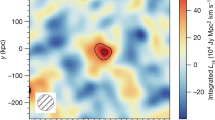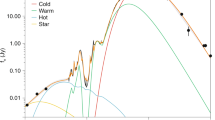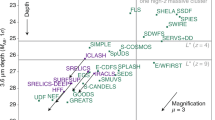Abstract
The deepest space- and ground-based observations find metal-enriched galaxies at cosmic times when the Universe was less than 1 Gyr old. These stellar populations had to be preceded by the metal-free first stars, known as ‘population III’. Recent cosmic microwave background polarization measurements indicate that stars started forming early—when the Universe was ≤200 Myr old. It is now thought that population III stars were significantly more massive than the present metal-rich stellar populations. Although such sources will not be individually detectable by existing or planned telescopes, they would have produced significant cosmic infrared background radiation in the near-infrared, whose fluctuations reflect the conditions in the primordial density field. Here we report a measurement of diffuse flux fluctuations after removing foreground stars and galaxies. The anisotropies exceed the instrument noise and the more local foregrounds; they can be attributed to emission from population III stars, at an era dominated by these objects.
This is a preview of subscription content, access via your institution
Access options
Subscribe to this journal
Receive 51 print issues and online access
$199.00 per year
only $3.90 per issue
Buy this article
- Purchase on Springer Link
- Instant access to full article PDF
Prices may be subject to local taxes which are calculated during checkout



Similar content being viewed by others
References
Hauser, M. G. & Dwek, E. The cosmic infrared background: Measurements and implications. Annu. Rev. Astron. Astrophys. 39, 249–307 (2001)
Kashlinsky, A. Cosmic infrared background and early galaxy evolution. Phys. Rep. 409, 361–438 (2005)
Kogut, A. et al. First year Wilkinson Microwave Anisotropy Probe (WMAP) observations: Temperature-polarization correlation. Astrophys. J. Suppl. 148, 161–173 (2003)
Abel, T. et al. The formation of the first star in the Universe. Science 295, 93–98 (2002)
Bromm, V. et al. Forming the first stars in the Universe: The fragmentation of primordial gas. Astrophys. J. 527, L5–L8 (1999)
Bromm, V. & Larson, R. B. The first stars. Annu. Rev. Astron. Astrophys. 42, 79–118 (2004)
Rees, M. J. Origin of pregalactic microwave background. Nature 275, 35–37 (1978)
Kashlinsky, A., Arendt, R., Gardner, J. P., Mather, J. & Moseley, S. H. Detecting population III stars through observations of near-infrared cosmic infrared background anisotropies. Astrophys. J. 608, 1–9 (2004)
Kashlinsky, A., Mather, J. & Odenwald, S. Clustering of the diffuse infrared light from the COBE DIRBE maps. IV. Overall results and possible interpretations. Preprint (1999).
Salvaterra, R. & Ferrara, A. The imprint of the cosmic dark ages on the near-infrared background. Mon. Not. R. Astron. Soc. 339, 973–982 (2003)
Magliocchetti, M., Salvaterra, R. & Ferrara, A. First stars contribution to the near-infrared background fluctuations. Mon. Not. R. Astron. Soc. 342, L25–L29 (2003)
Santos, M., Bromm, V. & Kamionkowski, M. The contribution of the first stars to the cosmic infrared background. Mon. Not. R. Astron. Soc. 336, 1082–1092 (2002)
Cooray, A., Bock, J., Keating, B., Lange, A. & Matsumoto, T. First star signature in infrared background anisotropies. Astrophys. J. 606, 611–624 (2004)
Kashlinsky, A. & Odenwald, S. Clustering of the diffuse infrared light from the COBE DIRBE maps. III. Power spectrum analysis and excess isotropic component of fluctuations. Astrophys. J. 528, 74–95 (2000)
Matsumoto, T. et al. Infrared telescope in space observations of the near-infrared extra-galactic background light. Astrophys. J. 626, 31–43 (2005)
Kashlinsky, A., Odenwald, S., Mather, J., Skrutskie, M. & Cutri, R. Detection of small-scale fluctuations in the near-infrared cosmic infrared background from long-exposure 2MASS fields. Astrophys. J. 579, L53–L57 (2002)
Odenwald, S., Kashlinsky, A., Mather, J., Skrutskie, M. & Cutri, R. Analysis of the diffuse near-infrared emission from Two-Micron All-Sky Survey deep integration data: Foregrounds versus the cosmic infrared background. Astrophys. J. 583, 535–550 (2003)
Fazio, G. G. et al. Number counts at 3 µm <λ <10 µm from the Spitzer Space Telescope. Astrophys. J. Suppl. 154, 39–43 (2004)
Fazio, G. G. et al. The Infrared Array Camera (IRAC) for the Spitzer Space Telescope. Astrophys. J. Suppl. 154, 10–17 (2004)
Barmby, P. et al. Deep mid-infrared observations of Lyman break galaxies. Astrophys. J. Suppl. 154, 97–102 (2004)
Fixsen, D. J., Moseley, S. H. & Arendt, R. G. Calibrating array detectors. Astrophys. J. Suppl. 128, 651–658 (2000)
Högbom, J. Aperture synthesis with a non-regular distribution of interferometer baselines. Astrophys. J. Suppl. 15, 417–426 (1974)
Kelsall, T. et al. The COBE Diffuse Infrared Background Experiment search for the cosmic infrared background. II. Model of the interplanetary dust cloud. Astrophys. J. 508, 44–73 (1998)
Kaiser, N. On the spatial correlations of Abell clusters. Astrophys. J. 284, L9–L12 (1984)
Bertin, E. & Arnouts, S. SExtractor: Software for source extraction. Astron. Astrophys. Suppl. 117, 393–404 (1996)
Bennett, C. et al. First-year Wilkinson Microwave Anisotropy Probe (WMAP) observations: Preliminary maps and basic results. Astrophys. J. Suppl. 148, 1–37, (2003)
Perlmutter, S. et al. Measurements of omega and lambda from 42 high-redshift supernovae. Astrophys. J. 517, 565–586 (1999)
Efstathiou, G., Sutherland, W. J. & Maddox, S. J. The cosmological constant and cold dark matter. Nature 348, 705–707 (1990)
Tegmark, M. et al. Cosmological parameters from SDSS and WMAP. Phys. Rev. D 69, 103501–103527 (2004)
Peacock, J. & Dodds, S. J. Non-linear evolution of cosmological power spectra, 1996. Mon. Not. R. Astron. Soc. 280, L19–L26 (1996)
Maddox, S., Efstathiou, G., Sutherland, W. & Loveday, J. Galaxy correlations on large scales. Mon. Not. R. Astron. Soc. 242, 43P–47P (1990)
Springel, V. et al. Simulations of the formation, evolution and clustering of galaxies and quasars. Nature 435, 629–636 (2005)
Oliver, S. et al. Angular clustering of galaxies at 3.6 microns from the Spitzer Wide-area Infrared Extragalactic (SWIRE) survey. Astrophys. J. Suppl. 154, 30–34 (2004)
Steidel, C. et al. Spectroscopic identification of a protocluster at z = 2.300: Environmental dependence of galaxy properties at high redshift. Astrophys. J. 626, 44–50 (2005)
Miralda-Escude, J. The dark age of the Universe. Science 300, 1904–1909 (2003)
Kashlinsky, A. Reconstructing the spectrum of the pregalactic density field from astronomical data. Astrophys. J. 492, 1–28 (1998)
Gautier, T. N., Boulanger, F., Perault, M. & Puget, J. L. A calculation of confusion noise due to infrared cirrus. Astron. J. 103, 1313–1324 (1992)
Ingalls, J. G. et al. Structure and colors of diffuse emission in the Spitzer galactic first look survey. Astrophys. J. 154, 281–285 (2004)
Wright, E. L. Angular power spectra of the COBE DIRBE maps. Astrophys. J. 496, 1–8 (1998)
Eisenhardt, P. R. et al. The Infrared Array Camera (IRAC) shallow survey. Astrophys. J. Suppl. 154, 48–53 (2004)
Cowie, L. L. et al. New insight on galaxy formation and evolution from Keck spectroscopy of the Hawaii Deep Fields. Astron. J. 112, 839–864 (1996)
Shapley, A. E. et al. Ultraviolet to mid-infrared observations of star-forming galaxies at z∼2: Stellar masses and stellar populations. Astrophys. J. 626, 698–722 (2005)
Hauser, M. G. et al. The COBE diffuse infrared background experiment search for the cosmic infrared background. I. Limits and detections. Astrophys. J. 508, 25–43 (1998)
Wright, E. L. DIRBE minus 2MASS: Confirming the cosmic infrared background at 2.2 microns. Astrophys. J. 553, 538–544 (2001)
Arendt, R. et al. The COBE diffuse infrared background experiment search for the cosmic infrared background. III. Separation of galactic emission from the infrared sky brightness. Astrophys. J. 508, 74–105 (1998)
Dwek, D. & Arendt, R. A tentative detection of the cosmic infrared background at 3.5 µm from COBE/DIRBE observations. Astrophys. J. 508, L9–L12 (1998)
Wright, E. L. & Reese, E. D. Detection of the cosmic infrared background at 2.2 and 3.5 microns using DIRBE observations. Astrophys. J. 545, 43–55 (2000)
Gorjian, V., Wright, E. L. & Chary, R. R. Tentative detection of the cosmic infrared background at 2.2 and 3.5 microns using ground-based and space-based observations. Astrophys. J. 536, 550–560 (2000)
Cambresy, L., Reach, W. T., Beichman, C. A. & Jarrett, T. H. The cosmic infrared background at 1.25 and 2.2 microns using DIRBE and 2MASS: A contribution not due to galaxies? Astrophys. J. 555, 563–571 (2001)
Acknowledgements
We thank G. Fazio for access to the IRAC Deep Survey data and D. Fixsen and G. Hinshaw for comments on drafts of this paper. This Article reports work supported by the National Science Foundation, and which is based on observations made with the Spitzer Space Telescope (this telescope is operated by the Jet Propulsion Laboratory, California Institute of Technology, under a contract with NASA). Support for this work was also provided by NASA through an award issued by JPL/Caltech. Author Contributions A.K. is responsible for the idea, clipping the maps, power spectrum and correlation analyses, evaluating the extragalactic contributions and writing the paper. R.G.A. is responsible for the images for analysis, providing the model of the resolved sources with the IRAC PSF, and evaluating systematics, instrument, and zodiacal and cirrus contributions. J.M. and S.H.M. developed analysis strategy and searched for alternative explanations for the fluctuations. All authors provided critical review of the analysis techniques, results and manuscript.
Author information
Authors and Affiliations
Corresponding author
Ethics declarations
Competing interests
Reprints and permissions information is available at npg.nature.com/reprintsandpermissions. The authors declare no competing financial interests.
Supplementary information
Supplementary Notes
This file contains Supplementary Figures 1–4, Supplementary Methods and Supplementary Discussion. (PDF 3384 kb)
Rights and permissions
About this article
Cite this article
Kashlinsky, A., Arendt, R., Mather, J. et al. Tracing the first stars with fluctuations of the cosmic infrared background. Nature 438, 45–50 (2005). https://doi.org/10.1038/nature04143
Received:
Accepted:
Issue Date:
DOI: https://doi.org/10.1038/nature04143
This article is cited by
-
The numerical frontier of the high-redshift Universe
Computational Astrophysics and Cosmology (2015)
-
Ultraviolet luminosity density of the universe during the epoch of reionization
Nature Communications (2015)
-
Implications of the cosmic infrared background excess for the cosmic star formation
Science China Physics, Mechanics and Astronomy (2013)
-
Reionization and the Cosmic Dawn with the Square Kilometre Array
Experimental Astronomy (2013)
-
Near-infrared background anisotropies from diffuse intrahalo light of galaxies
Nature (2012)
Comments
By submitting a comment you agree to abide by our Terms and Community Guidelines. If you find something abusive or that does not comply with our terms or guidelines please flag it as inappropriate.



